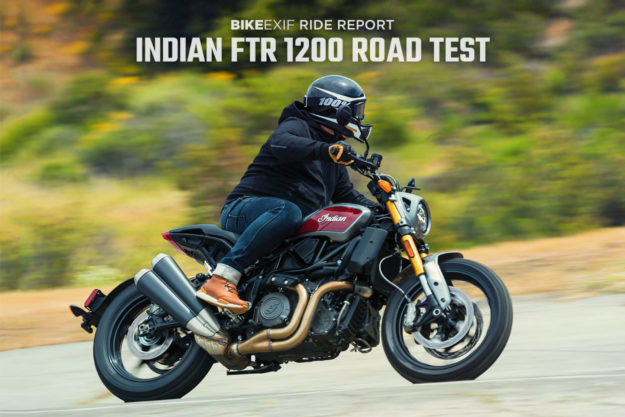
For a brand that only relaunched five years ago, Indian Motorcycle is making some bold moves. The Scout FTR750 racebike has cleaned up in the flat track scene and Indian has now released a matching flat tracker for the street: the hotly anticipated FTR 1200.
When the FTR1200 Custom concept broke cover 18 months ago, everyone with a pulse and a love for two wheels went all giddy. And even though the production-ready FTR 1200 has been watered down by practical and regulatory considerations, it’s every bit as appealing.
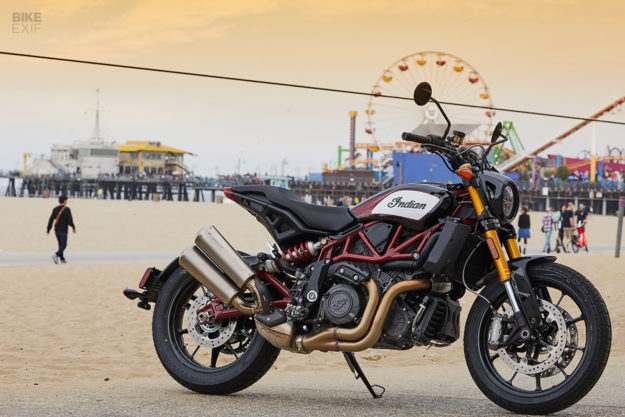
It’s as if Indian have taken the classic ‘win on Sunday, sell on Monday’ approach—but that’s only half the story. The motorcycle industry is morphing, and Indian are looking to attract younger, hipper riders; riders that want a slice of Americana, but have no interest in cruisers or baggers. (And yes, they’re obviously riding the wave of flat track racing‘s popularity, too.)
It’s also no secret that the American cruiser market is struggling. But Indian has seen significant growth in Europe—so the FTR 1200 is a bid to appeal to a wider audience, and pitched directly at European motorcycles.
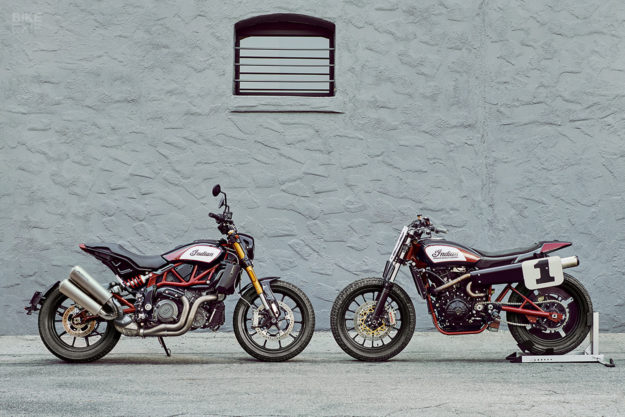
Does it succeed? Does the FTR 1200 look half as good in real life as it does in photos? And does it go as good as it looks? I headed to LA for a day of Californian canyon carving to find out.
Even when parked up, there’s a lot to like about the FTR 1200. It’s closer to a full-on flat tracker than any other production bike out there. Indian very wisely parked it next to their FTR750 racer at the launch, and the shared DNA is unmistakable.
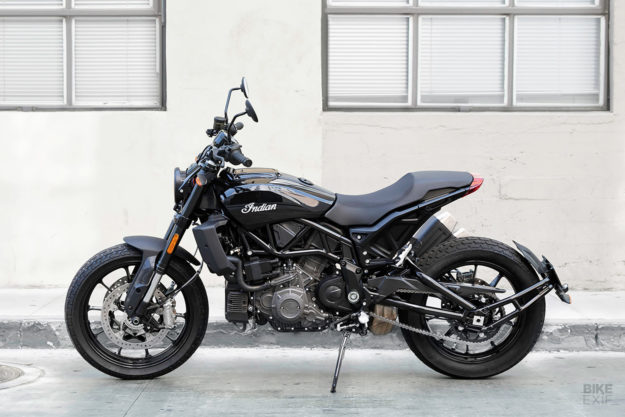
The FTR comes in three flavors: The $13,499 base model (above), the S version at $15,499, and the S ‘Race Replica’ at $16,999. The S is the benchmark and comes in two colors (below right); the base model sacrifices a number of features and comes in plain black, while the Race Replica adds Akrapovič cans, race replica paint and a red frame (below left).
All three share the same chassis, and the same liquid-cooled, 1,203 cc 60-degree V-twin motor. Numbers are respectable; 123 hp at 8,250 rpm, and 120 Nm of torque at 5,900 rpm. Power is handled by a slip assist clutch, a six-speed transmission and chain drive.
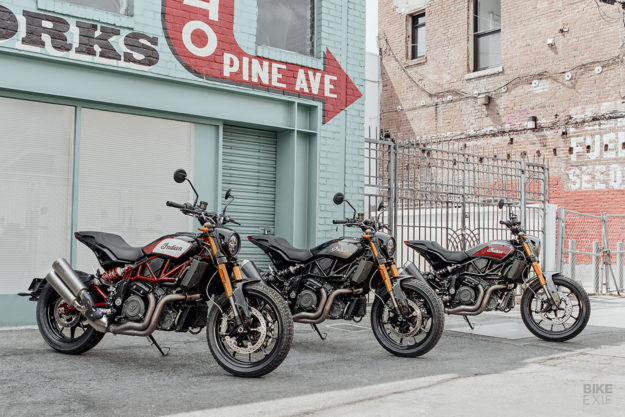
The S models also get a TFT touchscreen display, traction control and three switchable riding modes: rain, standard and sport. And they have additional rider aids like stability and wheelie control. The base model has an analog clock, no traction control, and no riding modes. Its fueling is equivalent to ‘standard’ mode on the S bikes.
All three models share the same Sachs suspension; 43 mm inverted forks and a mono-shock, with 150 mm of travel front and back. Both ends are fully adjustable for preload, rebound and compression on the S models, but on the base model, you only get preload and rebound adjustment at the back. Nothing up front.
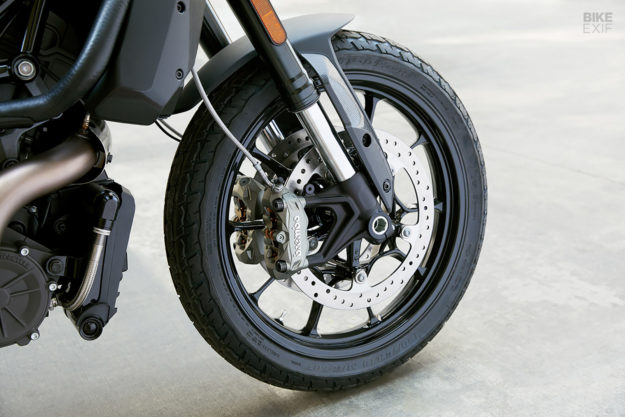
The ten-spoke alloy wheels are a perfect compromise between flat track style and day-to-day practicality: a 19” up front, with an 18” out back. (The 18” rear offers a wider tire selection than a 19” would.) They’re wrapped in Dunlop DT3Rs—road-ready versions of Dunlop’s popular DT3 dirt track tires, developed in collaboration with Indian for the FTR.
Rounding out the impressive parts spec are Brembo brakes, with twin 320 mm discs up front. ABS is standard on all models, but on the S it utilizes a six-axis IMU, and is switchable.
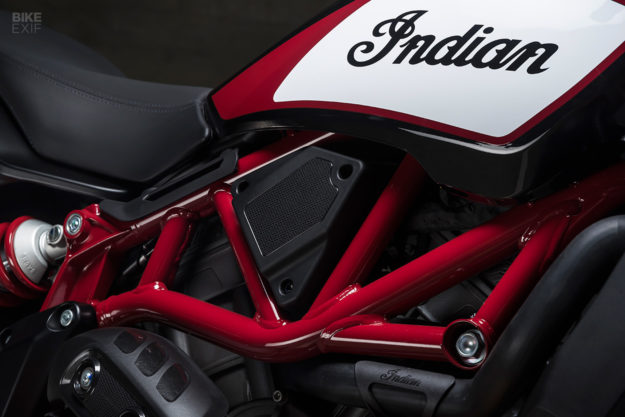
Everything’s packaged in a steel trellis frame, with an aluminum subframe. And it’s one hella clean package too. From the cable routing on the handlebars to a distinct lack of visible plugs and gadgets on either side of the motor, Indian’s design team went to great lengths to keep things as tidy as possible.
It’s quite a compact design too. The airbox sits right on top of the throttle bodies to improve airflow, with the 13-liter fuel tank dipping down under the seat. So the faux tank you see up top is really just a set of plastic covers, with a shape that mimics the FTR750’s tank flawlessly.
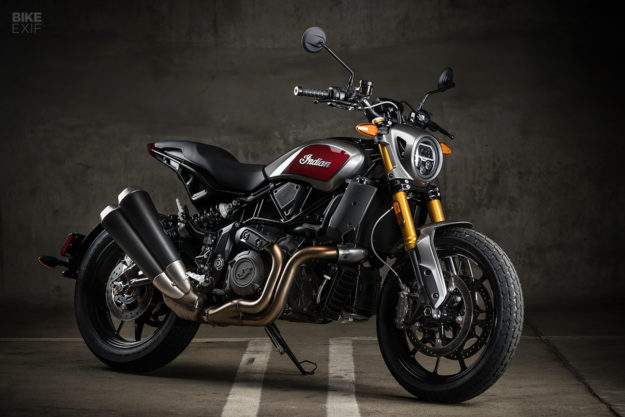
The FTR 1200 has a premium feel, right down to the paint. The base model’s black is a straight-up gloss black, but the two S paint jobs have a deep flake that’s just stunning when the sun hits it. And the Race Replica is a dead ringer for the race bike, with a multi-colored flake in the black paint that’s downright hypnotic.
The FTR 1200 does stray a little from the look of the FTR1200 Custom prototype. But according to the Indian product team at the launch, this was unavoidable. That concept had a one-gallon fuel tank, no airbox, an uncomfortable seat, and a high exhaust that ran hot—making it impossible to homologate and sell.
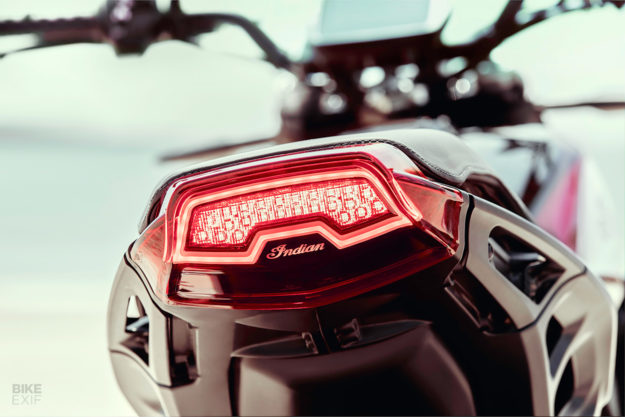
Still, there’s a lot to love on the FTR 1200. The LED lights at both ends look great, especially the taillight, which even has a subtle Indian script logo in it. I don’t even hate the chunky dual exhausts—though I will say that the Akrapovič option looks miles better, and the catalytic convertor lurking under the bike is an eyesore.
But it’s only when you swing a leg over the FTR 1200 that you realize just how much thought went into its development. Indian has absolutely nailed the ergonomics. It starts with the beefy ProTaper handlebars: they have a flat track feel to them, but the measurements are more suited to street riding.
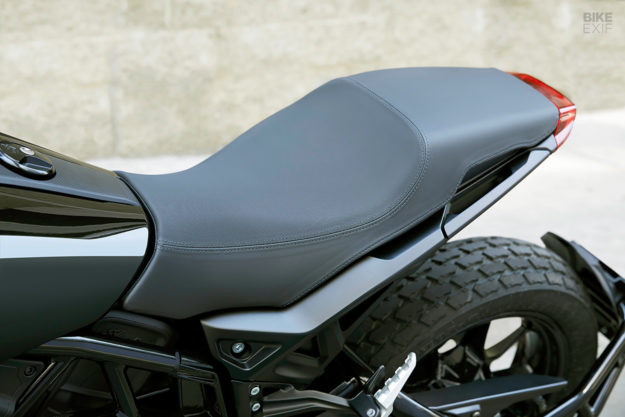
The foot pegs are ever so slightly back from mid, and tilted a touch forward. Combined with the seat height and bar position, it makes for a rider triangle that hits the sweet spot between comfort and control. Oh, and the seat is remarkably cushy too—even for a full day of riding.
The cockpit area is a letdown though. The TFT display on the S models is hit and miss—it packs a lot of information into an easy-to-read package, but the display itself is a lot smaller than the physical enclosure, and the graphics aren’t particularly great.
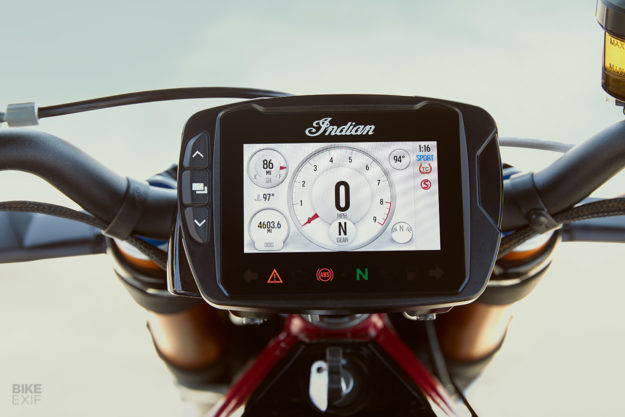
On the positive side, the touchscreen works great, and the unit has a lot of functionality—like the ability to interface with your phone and Bluetooth comms. But it’s also tricky to navigate.
There are three buttons on the switchgear, and three buttons on the display itself—some of which do the same thing. Switching modes means hitting one button to flick the display to the next screen, then either using the touchscreen or the joystick (which is on the other side of the bars) to pick your mode. (Oh, and you can’t switch traction control and ABS off independently.)
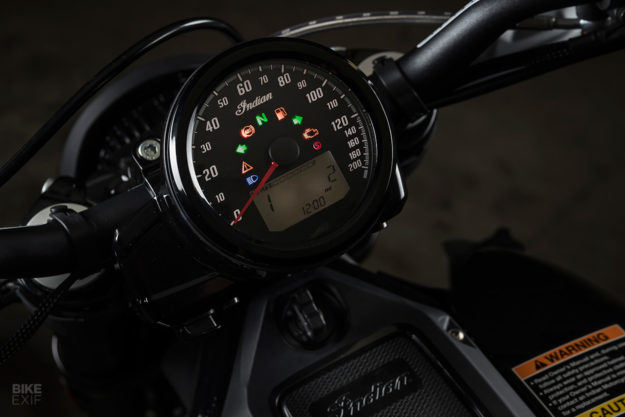
To be honest, I far prefer the analog clock on the basic FTR. Plus, the actual handlebar switches are incredibly dinky too, and the grips look and feel cheap. Which is a downer when compared the level of finish everywhere else on the FTR.
Can you look past these niggles when you’re out on the road? Absolutely. Indian took us on a route that lead out of Santa Monica along the Pacific Coast Highway, and into the twisty hills above Malibu for some spirited canyon riding.
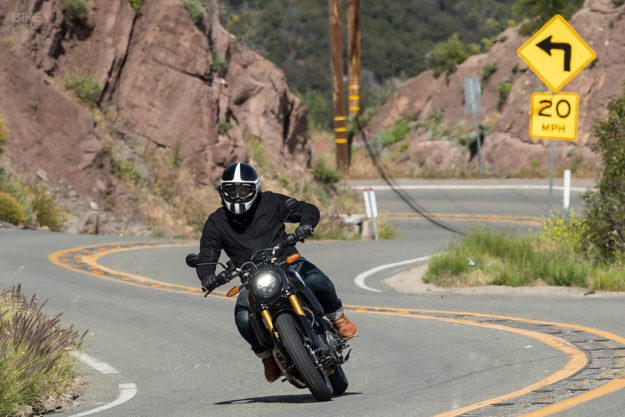
I spent most of my time on the S model, and it was bags of fun in the canyons—as soon as I got used to a couple of things. I applaud Indian for being brave enough to put street-legal flat track tires on the FTR, but it took me half of the day’s riding to get along with them.
I’m not sure if they just suck when they’re cold, or if I’m just not used to the way they behave, but there’s little to no feedback from the Dunlops. By lunchtime I’d figured them out, and realized I could push them a lot harder than I thought—and from a style perspective, they’re perfect.
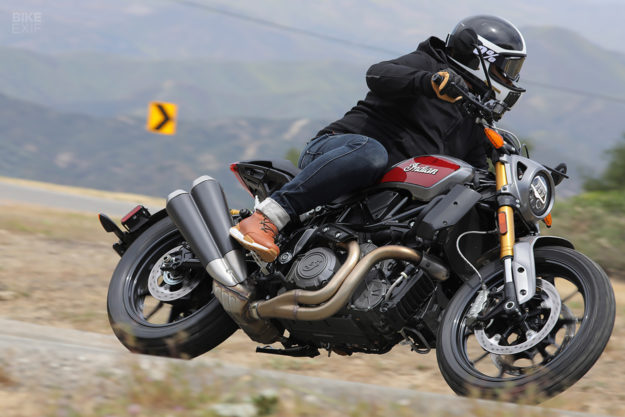
The 19F/18R wheel combo is not as sharp as a set of 17s would be, but that’s not necessarily a bad thing. It just makes for a different ride characteristic. Its compactness also belies how heavy it is. At 222 kg dry the FTR 1200 is several kilos heavier than the BMW R nineT, which is 208 dry and 220 full fueled. It’s a lot heftier than it looks.
To put this into perspective with other roadsters with sporting pretensions, the Ducati Monster 1200 is a mere 185 kilos dry, and the Triumph Speed Twin is 196 kg.
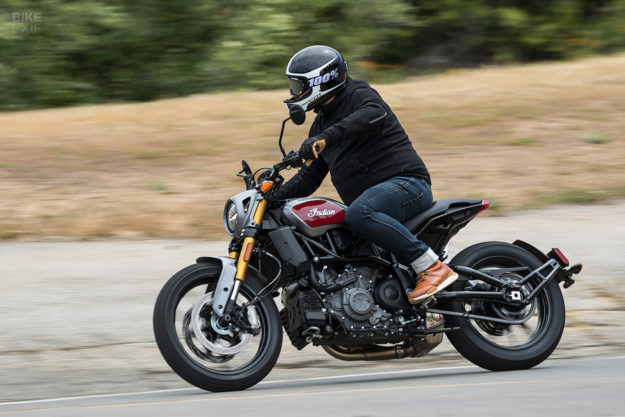
Luckily the FTR 1200 carries its weight well, with the low fuel tank helping to centralize mass. But it does mean that you need to manhandle it—rather than simply flick it—through corners.
The spot-on ergonomics help muscle it from turn to turn, and once you’re pitched over, it holds its line like it’s on rails. With the right kind of riding style, and plenty of body English, the FTR’s capable of setting a fast pace.
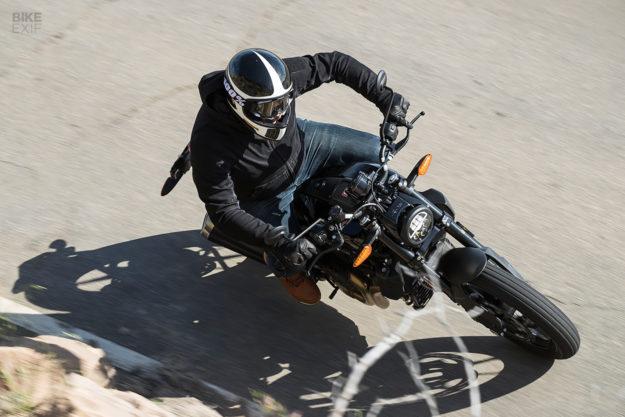
Thanks to solid suspension and brakes, it doesn’t get bent out of shape too easily either. Those Brembos are sharp and predictable, and the suspension felt dialed out of the box, even on shoddier road surfaces. (With extra room for adjustment, expert riders should be able to fine-tune it to perfection too).
Twisting the throttle will remind you that you’re riding a chunky American V-twin. There’s a lot of torque, but the throttle’s snatchy—even more so when you switch it into ‘sport’ mode. The FTR 1200 gets enough power down to keep you entertained, but current emissions controls have it sounding a little bunged up (even with the optional Akrapovič units).
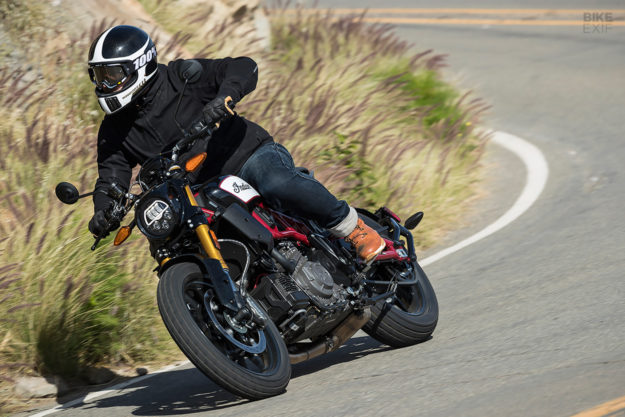
The slipper clutch is feather light, and shifts from the six-speed box are rock solid. I’ve been riding a lot of bikes with quick-shift systems lately, and immediately missed it on the FTR—but Indian’s people assured me it’s on their radar.
All in all, the FTR 1200 will give as much back as you’re willing to put in. Whack the throttle, trust the tires and throw your weight into it, and it’ll respond. Even the base model FTR is a hoot to ride, and might just be the ticket for riders that want a simpler bike, and don’t need to fuss with suspension settings.
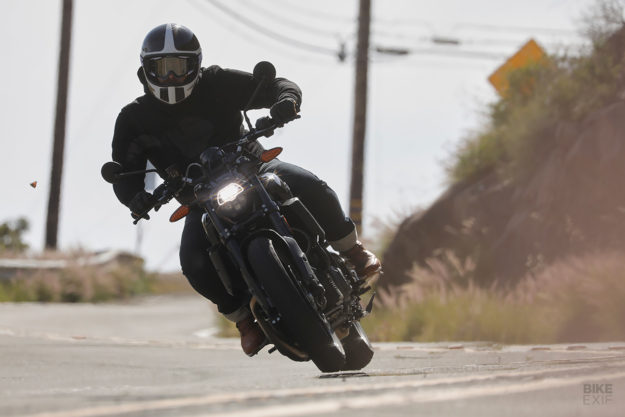
The FTR’s biggest win though, is what it signals for Indian. It’s a far cry from a cruiser or a bagger, but doesn’t sacrifice one iota of the brand’s heritage. Think of it as American muscle, with a European twist.
As for customization, Indian have launched four accessory packs alongside the FTR 1200. But in my opinion, they add too much fluff to what is essentially a super-clean bike, as OEM offerings go. I reckon customers are more likely to pick and choose individual pieces (like the carbon fiber body panels in the ‘Sport’ kit).
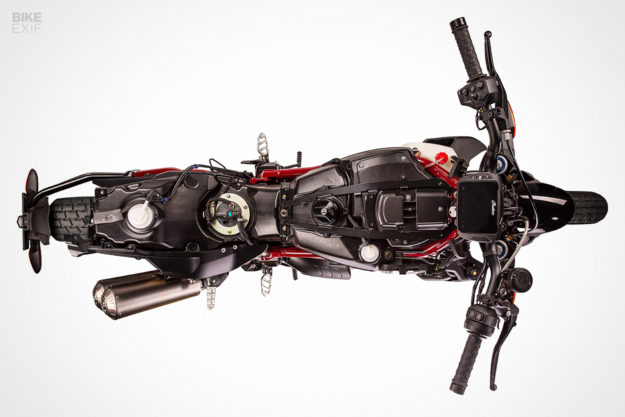
I asked Indian’s VP of Industrial Design, Greg Brew, how much room for pukka custom work there is, and he reckons there’s a lot. He has a point too—at the end of the day, the FTR has good bones, and in the right hands we could see some exciting builds come out of the woodwork.
He also mentioned that they’d been playing with a few configurations in-house, but wouldn’t get into specifics. What’s clear though, is that the FTR hints at a whole new platform for Indian, rather than just a one-off.
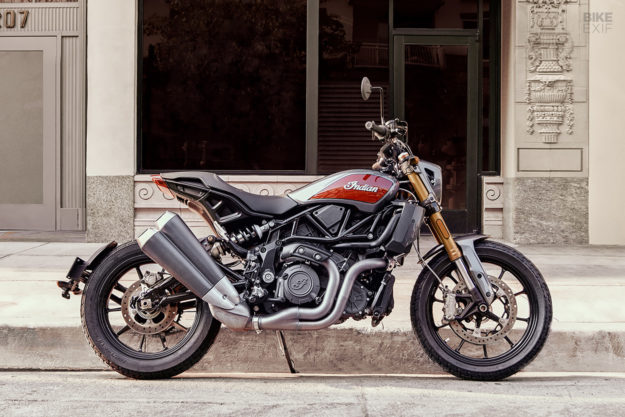
It’s also carving out its own niche. Its closest competitors in capacity and price are the BMW R nineT, Triumph Speed Triple or Ducati Monster, but none of those are quite the same bike. And Harley-Davidson’s product line is woefully missing anything that could compete.
And that’s really the FTR 1200’s biggest selling point. There’s nothing else like it.
Indian Motorcycle | Facebook | Instagram
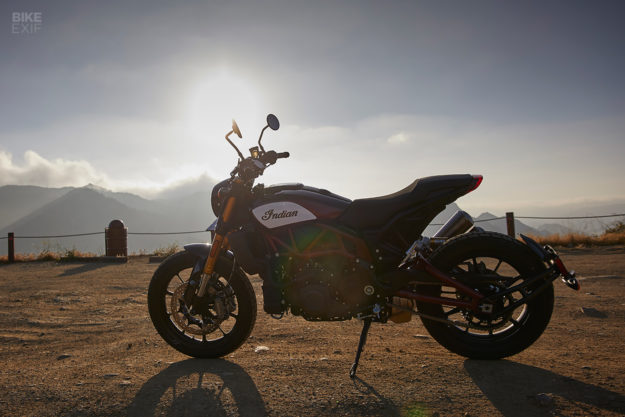
Pricing
US 1200: $13,499 | 1200 S: $15,499 | 1200 S RR: $16,999
EU 1200: €14,690 | 1200 S: €15,990 | 1200 S RR: €17,290
UK 1200: £11,898 | 1200 S: £12,999 | 1200 S RR: £17,290
Wes’ gear
Rough Crafts Revolator helmet | 100% Aircraft goggles | REV’IT! Stealth hoody | ICON 1000 Nightbreed gloves | Saint Unbreakable Stretch denims | ICON 1000 Varial boots